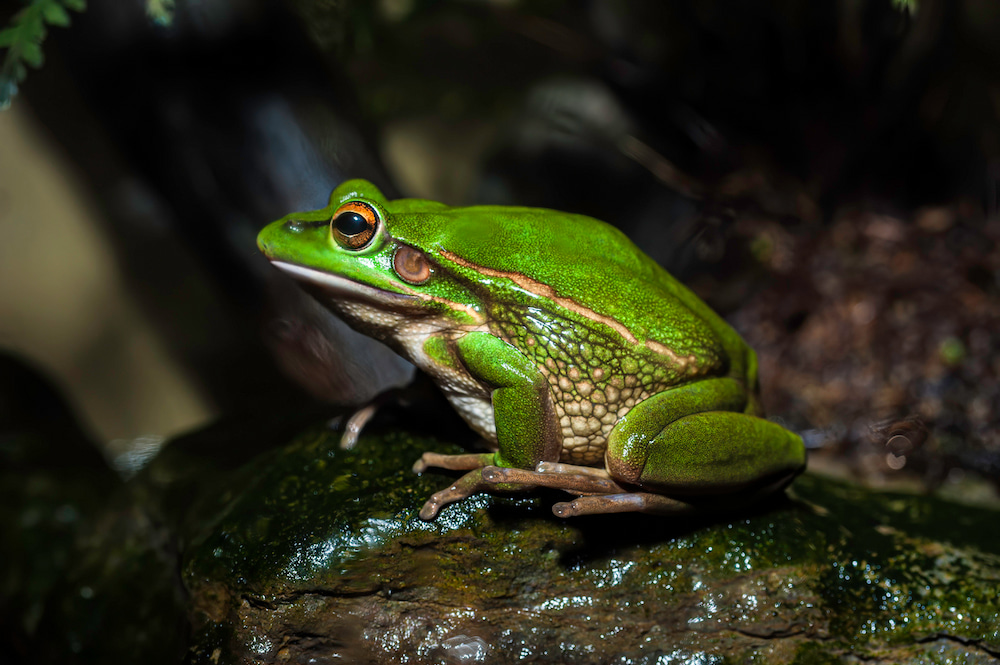Canberra’s wetlands will soon echo with the sound of a frog not seen in the ACT for 45 years – croaking, but not croaked, one might say. The resurgence of the green and golden bell frog, extinct here since 1979, might help bring other amphibians around the world, also threatened by a deadly fungus, back from the brink of disaster.
An ARC Discovery Project led by University of Canberra researchers proposes reintroducing immunised green and golden bell frog species to the ACT’s local ecosystem, coupled with habitat interventions across 25 wetlands in the Territory.
“The green and golden bell frog is a very charismatic little animal – its call sounds like a motorbike!” said Dr Simon Clulow, Senior Research Fellow in Invasion Ecology at UC. “There was one isolated highlands population left at Captain’s Flat, near Canberra, but no one has seen this particular frog there in about two years.”
Successfully reintroducing the frog could help solve the deadly chytrid fungus, which has caused the largest extinction crisis in amphibian populations around the world.
The fungus attacks the skin of frogs, in areas containing keratin, the protein that forms the skin’s building blocks. Frogs breathe through their skin, making respiration difficult; the fungus also affects electrolyte transport, which can lead to heart attacks.
The chytrid fungus has affected more than 500 frog species worldwide, and led to the extinction of four Australian species, Dr Benjamin Scheele, ecologist and Senior Lecturer at the Australian National University, said.
“The chytrid fungus is also behind the decline of corroboree frogs, which have been bred in captivity – but the problem is that the fungus remains in the environment, and attacks any frogs released into the landscape,” Dr Clulow said. “This is what has caused other attempts to bring the green and golden bell frog back, to fail.”
To overcome this problem, the green and golden bell frogs will be bred in captivity, and then immunised against chytrid to build resistance before they are released in the wild.
The researchers will also build habitat interventions across 25 ACT wetlands: salted satellite ponds that help block infection, and structures designed to create natural hotspots and provide respite from the cold conditions that the fungus needs.
“The one-time vaccination will increase the frogs’ resistance,” said Dr Clulow. “It will not be passed on to the next generation. That’s why the other part of this intervention involves environmental manipulations that create conditions which are good for the frogs, but not good for the fungus.”
The salted satellite ponds and hotspot habitat structures will be set up in four pilot wetlands this summer; the frogs for release will be bred at Symbio Wildlife Park, and possibly the University of Canberra.
“It will then be about a year and a half of work before we have all 25 wetlands set up and suitable for the reintroduction of the bell frogs,” Centenary Professor Richard Duncan at UC’s Faculty of Science and Technology, said.
After the frogs are released, the researchers hope citizen scientists and community members will look out for and record sightings of the frogs, and to take part in surveys with FrogWatch.
“From this project, we expect to see how relatively straightforward habitat manipulations might allow the frogs to co-exist with the pathogen,” Professor Duncan said.
And understanding the impact of such interventions for the green and golden bell frog will pave the way to save other amphibians around the world, anywhere they are impacted by chytrid.
The Restoring amphibian populations in chytrid-impacted landscapes project was awarded more than $900,000 in funding in the latest Australian Research Council (ARC) Discovery Project round. Its project partners include the ACT Healthy Waterways Program and Office of Nature Conservation under the ACT Government, Gininderry Conservation Trust, FrogWatch ACT, NSW Department of Planning and Environment, and Symbio Wildlife Park.
- Based on an article by Suzanne Lazaroo, University of Canberra



